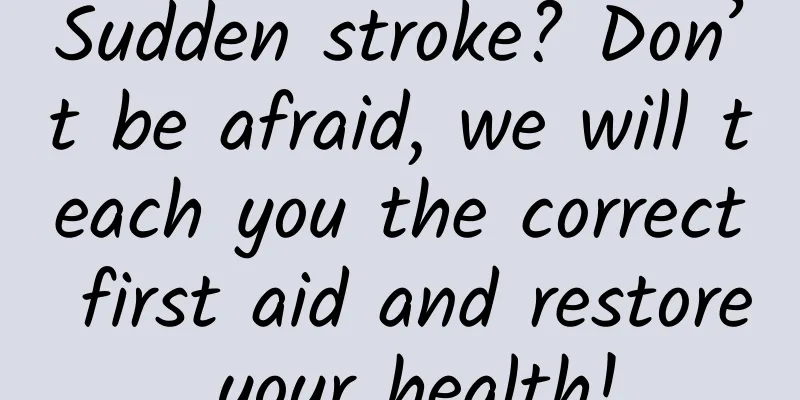Sudden stroke? Don’t be afraid, we will teach you the correct first aid and restore your health!

|
Author: Li Zhi Sichuan Meishan Cardiovascular and Cerebrovascular Disease Hospital Reviewer: Zeng Junyan, deputy chief physician, Sichuan Meishan Cardiovascular and Cerebrovascular Hospital Stroke, commonly known as "stroke", is an acute cerebrovascular disease that has attracted much attention for its high morbidity, high disability rate and high mortality rate. With the aging of the population and the change of lifestyle, the prevention and treatment of stroke has become an important issue in the field of public health. Today, we will introduce you to the relevant knowledge of stroke in depth, improve your self-identification ability, pre-hospital emergency level and the importance of subsequent treatment. 1. Understanding stroke: a health killer that cannot be ignored Stroke is an acute disease caused by the sudden rupture or blockage of blood vessels in the brain, which prevents blood from flowing into the brain or damages brain tissue. According to the cause, stroke can be divided into two categories: ischemic stroke and hemorrhagic stroke. Ischemic stroke accounts for about 80% of all strokes and is mainly caused by thrombosis or embolism; while hemorrhagic stroke includes cerebral hemorrhage and subarachnoid hemorrhage, which are mostly caused by factors such as hypertension and aneurysm. Figure 1 Copyright image, no permission to reprint The symptoms of stroke vary, but usually manifest as sudden neurological deficits, such as weakness or numbness of one side of the limbs, slurred speech, blurred vision, dizziness, balance disorders, impaired consciousness, etc. The appearance of these symptoms often indicates that the brain has been severely damaged, so rapid identification and timely medical treatment are crucial. 2. Rapid identification: Seize the golden time for treatment 1. FAST principle The FAST principle is a method for quickly assessing stroke patients, consisting of four steps: Face, Arm, Speech, and Time. (1) Face: Observe whether the patient’s face is symmetrical, whether there is any crooked corner of the mouth, numbness on one side of the face, or abnormal expression. Figure 2 Copyright image, no permission to reprint (2) Arm: Ask the patient to raise both arms horizontally and observe whether one arm is weak or unable to maintain balance. (3) Speech: Ask the patient whether he can speak fluently, pay attention to whether his speech is clear, and whether he has difficulty expressing himself or is unable to understand the words of others. (4) Time: If any one or more of the above symptoms occur, call the emergency number immediately, record the time of onset, and send the patient to the hospital as soon as possible. 2. Other common symptoms In addition to the symptoms mentioned in the FAST principle, stroke patients may also experience severe symptoms such as severe headache, vomiting, vision loss, unsteady gait, and impaired consciousness. Once patients experience these symptoms, they should pay attention and seek medical attention immediately. 3. Pre-hospital emergency care: buying time for life In the pre-hospital emergency stage, correct treatment measures can significantly improve the patient's survival rate and quality of life. The following are some key pre-hospital emergency measures. (1) Stay calm and call the emergency number immediately: When you find a patient suspected of having a stroke, you should remain calm, call the emergency number quickly, and inform the patient of his or her condition and location. (2) Keep the patient's airway open: Place the patient in a supine position with the head tilted to one side to prevent vomitus or secretions from blocking the airway. (3) Avoid moving the patient at will: Do not move the patient at will unless necessary to avoid aggravating the patient's condition. If the patient needs to be moved, do it steadily and slowly, and try to keep the patient's head stable. (4) Monitor the patient's vital signs: If conditions permit, the patient's vital signs such as blood pressure, heart rate and respiration can be monitored to provide valuable reference information for doctors. (5) Do not give medication or food at will: Do not give medication or food to the patient at will before the patient's specific condition is clear, so as not to aggravate the condition or cause other adverse consequences. IV. Treatment and rehabilitation: hope for rebuilding life 1. Acute treatment Once a patient is diagnosed with a stroke, acute treatment should be given immediately. For patients with ischemic stroke, time is of the essence, and thrombolytic therapy or intravascular therapy should be performed as soon as possible to restore blood supply to the brain. For patients with hemorrhagic stroke, a corresponding treatment plan should be formulated based on the amount and location of bleeding, and surgical treatment should be performed if necessary. 2. Rehabilitation Rehabilitation therapy is an important part of restoring function and improving the quality of life for stroke patients. Rehabilitation therapy includes physical therapy, occupational therapy, speech and swallowing therapy, psychotherapy and other aspects, aiming to help patients restore motor, sensory, cognitive and other functions, reduce the degree of disability and improve their ability to take care of themselves. 3. Long-term management Stroke patients still need long-term management after discharge, including controlling risk factors (such as hypertension, diabetes, hyperlipidemia, etc.), adjusting lifestyle (such as quitting smoking and limiting alcohol, eating a reasonable diet, exercising moderately, etc.), regular review and follow-up, etc. Through comprehensive management and scientific intervention, the risk of stroke recurrence can be effectively reduced and the quality of life of patients can be improved. Stroke is a serious cerebrovascular disease, but its prevention and treatment are not without solutions. By improving self-identification ability, mastering pre-hospital emergency skills, receiving timely and effective treatment and rehabilitation training, and carrying out long-term management, we can effectively cope with the challenges of stroke and protect the health of ourselves and our families. |
<<: Scientifically protect the knee joint and effectively prevent knee joint injuries
>>: Colorful food suitable for patients with cardiovascular and cerebrovascular diseases
Recommend
What is the temperature and weather like in Yunnan in July? What should I wear when I go to Yunnan in July?
Yunnan is suitable for traveling all year round. ...
Function of uterine ligaments
We all know that the human uterus is fixed by the...
Inke: Revenue in the first half of 2020 was 2.2 billion yuan, up 48% year-on-year
On August 26, 2020, Yingke Interactive Entertainm...
Causes of postpartum bleeding
Postpartum bleeding during sex may be caused by v...
What to do if urethritis recurs
Patients with urethritis have an experience, that...
Does insufficient blood and qi affect menstruation in women?
Blood and qi are very important for the body. Ins...
Girls have pain when doing it
When girls have sex, private pain may be caused b...
Can a urinary tract infection affect menstruation?
Health is everyone's wealth, especially for w...
What is the hcg value in early pregnancy test?
Physical examinations are required during pregnan...
Will cataracts cause itching and pain? What will happen when cataracts develop?
Cataract is an eye disease and the leading cause ...
Causes of menstruation during pregnancy
I have a friend who is pregnant. We are all happy...
How to remedy drinking cold boiled water during confinement
Female friends must pay more attention to their d...
Reasons why ovarian follicles do not rupture after ovarian stimulation
The most concerning thing during the pregnancy pr...
Did you know that some people are more susceptible to cancer than others?
This article was reviewed by Dr. Guo Xiaoqiang, a...
How long does it take for women to have menstruation after taking the gold tablets?
Any medicine should not be used indiscriminately ...









